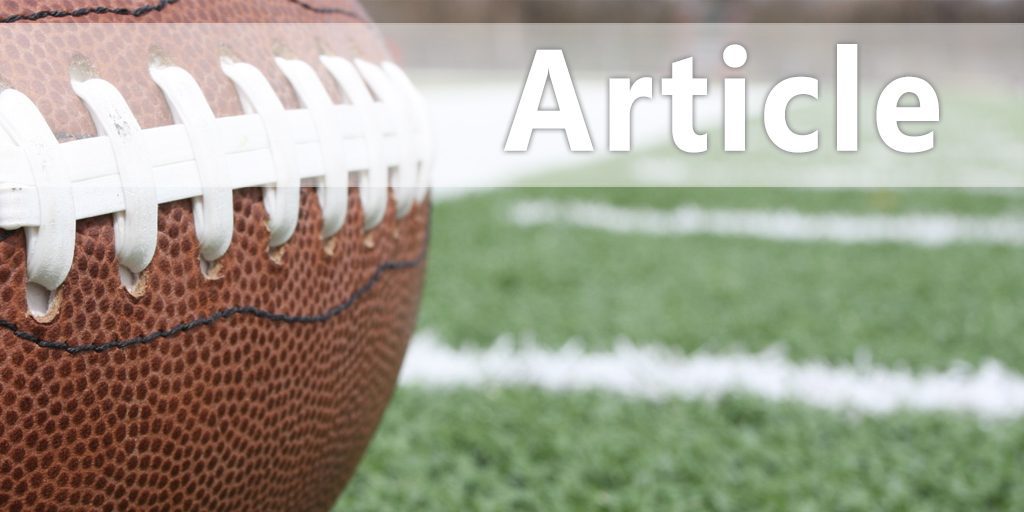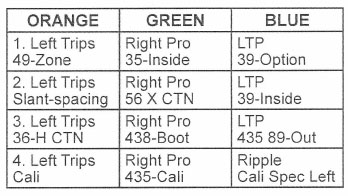| The No Huddle Hurry Up Offense
Originally Published - Nike Coach of the Year Clinic Notes - by Earl Browning
During our season this year, one word started to upset me. It really started at the end of the season when we started into our playoffs. When people started talking about our football team, they talked about all the talent we had. I started to resent the word talent in a certain way. They talk about talent as if the player had something to do with it. They are hard working players and work at developing the talent they have, but their parents are the reason they have talent. When you talk about a player, you need to talk about how hard working he is. When you talk about a team, talk about how well they execute. I do not let the media or others get away with talking about how talented we are. They may think that is a compliment, but I take is as a slight sometimes. What I want to talk about is how we take the types of offenses we run and put it into a No-Huddle System. We are not a no-huddle team. We huddle 90 percent of the time. We use the no-huddle as a change up in a game. I relate that as a pitcher with a 98 mile an hour fast ball. He has the hard fast one, but he can throw the 91 mile an hour change up. The change up pitch makes him much more effective. Our players wear wristband. If you want to make a lineman happy, give him a wristband. We are on a very successful run at our school. The senior class that will graduate this sprint won 57 out of 59 games. In winning those games, we put up a bunch of points. • Any personnel groupings that you chose • Blue (1 rb, 1 te, 1 wr, 2 hb) • Green (2 rb, 1 te, 1 wr, 1 hb) • Orange (1 rb, 2 wr, 2 hb) • White (1 rb, 2 te, 2 hb) When I put together a presentation, I do it from a journalistic point of view by telling who, what, when, where, and why. The first part of the presentation is "who" it is. We do this with every personnel group we have. We go into every week with 10 and 11 personnel groups. The third personnel group will depend on what team we play. In some weeks, it could be 12 or 20 personnel. When we set up our personnel groupings, we color code them on the wristbands and in our practice schedule. Our eleven personnel group is blue. Another one is orange, white, brown, and so forth. • Hurry-up, flurry style of offense • 4 plays determined by game plan • Quick snap count • An opportunity to catch a defense unprepared When we use the hurry-up, no-huddle scheme we refer to it as our "dog bite series." The "what" is a "Hurry-Up" style of offense? It is four plays that goes on our wristband. It has a quick snap count. It is an opportunity to catch the defense unprepared. It is an opportunity to take advantage of a defense that is not in very good condition. We feel good about the strength and conditioning of our team. We think we can take advantage of that with our Hurry-Up offense. • Should be able to run the first play from the M.O.F. • Should be able to run the first play from either hash mark. • Subsequent plays determined by likely end of previous play. The "where" has to do with the development of our game plan and our package? The first thing we must decide is can we run the play from the right hash, middle of the field, and the left hash mark. If the play is a 3 X 1 we may not want to put three receivers into the boundary. That could not be the first play in that series. The second play in the series is where we think the first play will end. The formation for play three will be where we think play two will end. The sequential plays will come with that thinking in mind. There is a list of the "when" we use it. We find the most effective time to use the no-huddle. • After a big play. • If our offense is lethargic. • If our defense is on its heels. If you hit a big four vertical play or run a draw for a 20-25 yard gain, that is a good time to run the no-huddle hurry-up offense. You have a defense on the field that is looking at each other and trying not to blame someone. The sidelines may be in disarray and the coaches are overly excited about giving up the big play. That is when we want to jump on them with another play. If the offense is getting lethargic and lazy, this is a good time to use the no-huddle. If the offense is getting sloppy and not getting into and out of the huddle, we want to stir things up and get them to concentrate. This picks up the tempo and forces them to align quickly. If we have scored two possessions in a row, we may use it. We have the defense down and we want to go for the knockout punch. If their confidence dips that is a time to jump on them. It is a flurry style of offense. It is like a boxing match on TV. If one of the boxers stuns the other, they move in, start throwing haymakers, and try to knock the other fighter out. • Create your own "sudden change" effect • Take advantage of a defensive personnel package • Take advantage of a poorly conditioned team • Mayday! It creates a sudden change effect. If there is turnover by the offense, the defense coming on the field has to be ready for a quick attempt at a score. It could be a trick play or play action pass. If we have been running off tackle continually, we jump into it to speed things up and get the focus back on track. It gives your offense a greater sense of urgency. If the defense brings a heavy defense on the field to stop the run, we may want to speed the game up and make them run. We can take advantage of a particular personnel package they have. If they have a nickel package on the field, we can jump into the hurry-up and not give them the chance to change personnel. If we put our power package in the game, it is to our advantage. Now you have defensive backs taking on pulling guards and fullbacks. It gives us the opportunity to catch the defense with 12 players on the field if they try to change personnel. It lets you take advantage of a poorly conditioned team or a team that is not in as good of shape as you are. In North Carolina early in the season, there are extremely hot weather conditions. We feel we are in better shape than most of the teams we play early. If we go to the no-huddle two or three times in a half, it wears the other team down. The last "why" occurs in a short yardage situation? If we have a third or fourth down and short yardage situation, we may go into a one play "dog bite." We call "May Day", and we do not huddle, and we run the play quickly. This is not a series or two series; it is a one play down. We line up quickly, run a wedge-blocking scheme, and run the ball to pick up the first down. It is a another way attack a defense that is not ready. We do this in our JV program. We use the same four plays the entire season. In our JV games we do not exchange film and no one scouts those games. It allows us to train the younger players in the system. We use it as part of our conditioning program. We run through our "dog bite" series repeatedly. It helps them learn the plays. We get some physical benefit out of it. Nine years ago, we only used one or two personnel groupings a game. Our offense over those years has evolved in to what we do today. The evolution occurred because of mistakes we made previously. We played Independence High School five years ago. They had a 97 game winning streak going. We kicked off to them and they fumbled the ball on the first play of the game at their four-yard line. At that time, we did not have a 21 personnel group in our offense. We ran the ball three times in a row out of a one-back no tight end set and they stuffed us all three time. On the third down play the quarterback got a penalty for trying to push the running back into the end zone. They took the penalty and we threw the ball on the repeated third down play. They picked it off and ran 99 yards for the touchdown. We felt we were better than they were, but that deflated us, and we lost the game. On Monday, we installed a three back goal line set on offense. That failed goal line situation taught us a lesson. That was something we added to our toolbox. • They are kids, they make mistakes (do not read it right, skip plays) • Wrong Cards (See changes, collect old ones) • Chain Gang (slooooow) • War Zone This is not a perfect system. Your players are kids and make mistakes. You might be in a "blue" personnel group and they read the red personnel grouping call. Sometimes they read the wrong cards on the sideline calls. In one game, a receiver kept aligning in the wrong formation. We took him out of the game, checked his card in his wristband, and he was running the card from the previous week. We corrected that the next week by not laminating the cards until game day. They used paper cards all week and we replaced them on game night with laminated cards. You must make sure your chain crew has someone on the downs marker that can get up and down the field. The year before, we had an older teacher on the downs marker. We constantly had to wait for him to set the downs marker in the games. We called for the "dog bite" series and had to wait on him to get the downs marker set. Luckily, he got a pacemaker this year and did a much better job of getting the marker set. You do not want the referee or downs marker slowing you down. If you play on the road, the chain crew may be slow on purpose to give the defense a chance to catch their breath or substitute. If you give an offensive lineman a wristband, it makes his day. We had one player the team nicknamed "War Zone." He took his "dog bite" card and on the backside he drew pictures of tanks, planes, and war zone stuff. That became his nickname. It is silly stuff but that is the fun things about working with high school players. The following is an example of what the dog bite card looks like. The first thing on the card is the Dog Bite vs. (Opponent) the name of the team we play. It is a safe guard to make sure we have the proper card. We list the personnel groups we will use against the opponent for that week. In this particular example, we are using the Orange personnel grouping, which is one running back, two-wide receivers and two H-backs, using Green personnel and Blue personnel. Dog Bite Vs. __________ When you develop your plan you do not want your players running from one side of the field to the other to get into the proper formation. In the first example, the formation was "left trips" for all four plays. You do not want to go from left trips to right trips in your sequence. You wear your own players out with too many formation changes. In the case of a play to the wide side, we may simply put trips out with no direction designation on the card. If we want to run the bubble screen from the trips set, we want it run into the wide side of the field. After your players become experienced at running the dog bite, they know the bubble screen goes into the wide side. If the ball is on the left hash mark, the offense knows we are going to be in right trips. The fun thing about coaching is when the players start to think as you do. That is when you know they have a good grasp of what you are trying to do with the dog bite series. You can be flexible in a given week. You may not want to use three personnel groups in the dog bite. The personnel grouping are something that we use. It is not a rule that you need three personnel groups. It is something that we did to be as versatile as we can. The only thing that limits what you want to do is your own creativity. • Formation is on the card or can be signaled in (ex. trips) (slide 11 vs. man press) • Immediately when you get lined up • Ball is snapped on a quick count (first sound) At the end of a play, the dog bite call comes from the sidelines. The coaches start to yell at the players on the field. We make the color call. In this example, we yell "Orange-1." Everyone looks at their card and sees the play we run. When the play is over, we come back to the line of scrimmage immediately and run Orange-2 from the card. The first thing we must do before we run each play is align. We need to do that as quickly as possible. Once we get into the formation, we look at the card to see what the play is. It is important to align quickly because the other version of this package is our "mad dog" package. The dog bite series always goes on the first sound. If we call "man dog", we look for the free 5 yard penalty for the defense jumping off sides. It is a dummy call, which we do not snap on the first sound. We have our staff meetings on Sunday night. In that meeting, we establish what the dog bite series is going to be. The plays on the card are predetermined plays, which come from our Sunday staff meeting. We type it up, put it on the game sheet, and work on it during the week. It does not change. If we have confidence to run this series, we know where the defense will align on these sets. However, they do not always end up where we think they will be. It does not matter where the defense aligns you still have to block them. If they do not align where we tell our players where the defense will be, they have to adept and apply their rules. That is one reason you need simple line blocking assignment. We feel we can block any blocking scheme. Some plays in the grouping are predictable as to where they will end. However, some other plays could end up somewhere else particular if it is a pass play. That is the reason for some of the open formations directions. If we run trips left into the wide side of the field and run a running play to the right, we know the play will end up into the boundary. We call left trips again and know the formation will be to the wide side of the field. When you run this type of scheme, you would not think you would want to motion or have the ability to motion. Four years ago, we started to use motion with this series. When we did it, the offensive line jumped off side quite a bit. The offensive line was not patient enough. They knew it was the dog bite. They wanted to get into their stances and get off the line of scrimmage. One of the best things you can do in the dog bite is run an unbalanced formation. The other system we use is the "Mad Dog" system. In this system, we can use it as a two-minute offense. We want to continue to get to the line of scrimmage quickly. We signal the formation from the sidelines. When we go to the "mad dog" system, we hustle to the line and get set. The quarterback goes to a dummy cadence. The first sound that comes out of the quarterback's mouth is going to be loud and forceful. We try to get the defense to jump. However, it serves another purpose. We run the "dog bite" enough so that it draws a reaction from the defense. Even if they do not jump off sides, they will tip what they are going to do. The secondary will move and if they plan to blitz, it will show. You get a great read for what you want to run. This year we ran for over 3000 yards and threw for 3500 yards. Our percentage of run to pass was 60-40 percent run to pass. We have done that without a seasoned quarterback. We had a veteran quarterback this year but he broke his hand half way through the season. I told our quarterback this year before he broke his hand, in the "mad dog" system that I was going to let him call the plays. If you have a quarterback that has run the system, that is the way to go. If he understands the offense and knows what you are trying to do, it is the best way to do it. If you want to build confidence in your quarterback, let him call the plays. He wants to do it right and will work hard to make sure he does it right. If you trust the quarterback to make the right calls, the rest of the team will trust him. They think if the coach trusts him to run the offense, then I am going to trust him. That gives your offense a big shot in the arm. When we get into the "mad dog" mood, we call our offense with a one-word cue or signal. Our curl/flat combination is "New York." If the quarterback calls "New York", the outside receiver runs the curl route and the number 2 receiver runs the bench route. It could be a flat or out cut. We call all of our formations with hand signals. Carolina is curls/corners pass. Instead of calling Carolina, we could use Tar Heels or Wolf Pack. Instead of calling New York, we could Jets or Giants. Tennessee is our toss sweep. If we called Tennessee, we run the play to our sidelines. If we called Tennessee opposite, we run it to the opponent's sidelines. If we run the sprint out series, we run companion patterns depending on the second number in our sixty series. If we call "64", the second number is the pattern for the outside receiver. The wide receiver run the 4 route and the inside receiver runs the companion route. We try to match a high/low read for the quarterback. The 4 route is the inside curl and the companion route is a flat pattern. If we run "69", the outside receiver runs the 9 pattern, which is a takeoff, and the inside receiver runs a low breaking pattern, which is a bench or out route. We pick small things that are easy to remember and make use of them. We rep them during the week, hit it hard on Wednesday, Thursday, and try to do it on Friday. There will be games where we do not use dog bite or mad dog one time. There will be weeks where we do it a couple of times. We do it that way and the players like it. I am sure there will come a time when we feel like we have too much for the players to comprehend. When that happens, we start subtracting. In a no-huddle or two-minute offense at the end of a half, you do not need too many plays. We have three to four things that we can run. We have the wide play with Tennessee, the inside zone, and a draw. The defense is not going to play eight players in the box. You do not need a complicated pass blocking protection schemes. Our protection scheme is the same with the exception of the sprint out pass protection. If you put too much offense in these situations, you end up with more blocking schemes than you need. We rep the four plays in the dog bite in practice every day. We have three formations and four plays in each formation. It takes us about 45 seconds to run one four-play series. We do not spend a lot of practice time running plays. When you are a multiple formation offense, it is easy to add a lot of formations. For us to add a formation, we have to be able to do four things from the formation. You must run your base run and counter run from the formation. You must be able to play action pass and drop back pass from the formation. If you can do that from the formation, we can consider adding it. We do not have freshman football at Butler. We have JV and varsity football. After the game on Friday, we do not meet with the team until Monday. We give them the entire weekend off. We ask a lot of them during the week and they deserve the weekends to do whatever they want. On Monday, the offensive players come to my classroom and we watch the game film. The defensive players go to the defensive coordinator's classroom and watch the game film. On Monday, the JV team goes out and has a scrimmage. That is a heavy and physical workday for them. The staff has from Friday night after the game until Sunday night at the staff meeting to do the things that is required of them. They have to watch the game tape and grade their position groups. We meet as a staff on Sunday and make all the preparation for the upcoming week. On Monday, the varsity goes to the practice field around 3:45. We work for about an hour to an hour and fifteen minutes. We go over the next opponent, put in our installs, and go over the formations we will use. The normal weekly practice begins at 3:00 and we are off the field at 5:15. That includes stretch time and conditioning. I want to talk to the assistant coaches. Some of you think you are ready to be a head coach. You have done all your work and accomplished a bunch of things. My advice to you is to be patient. You are always going to have time to take a bad job. I was at Butler for 6 years. The head coach took another job down the road and I got the opportunity to be the head coach. A job may look good on the outside, but those situations are rarely good situations to take on. It has been a pleasure to talk football with you. I appreciate it and I am overwhelmed and impressed by the turnout today. When I tell my staff about the reception I got here, they will understand why the football is so good in Florida. If there is anything else you want to talk about I will be around all week-end. Thank you. |







